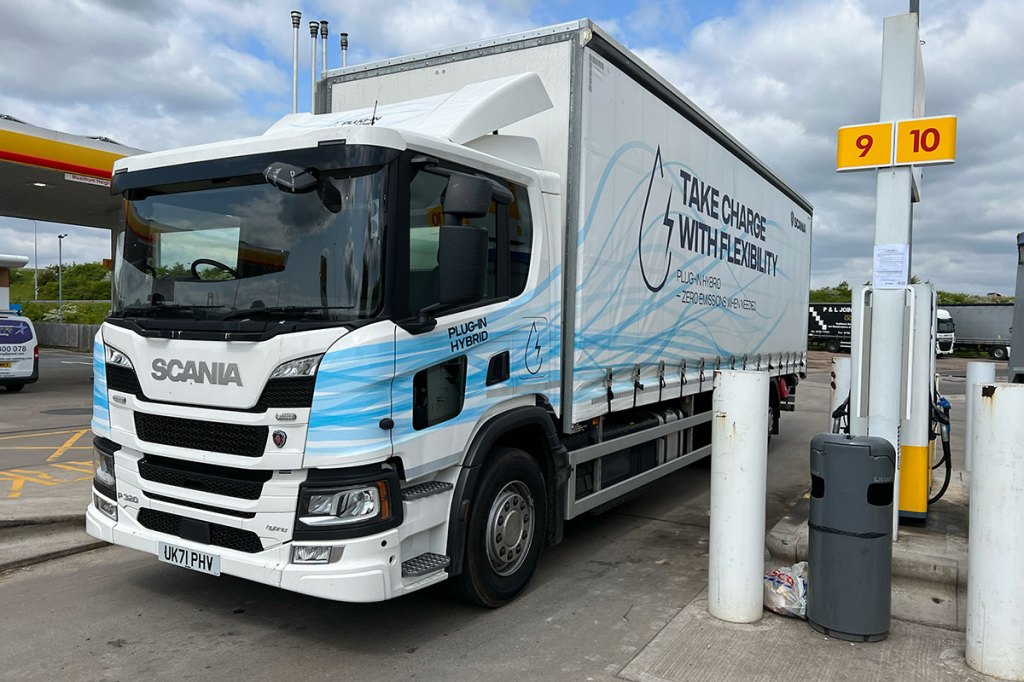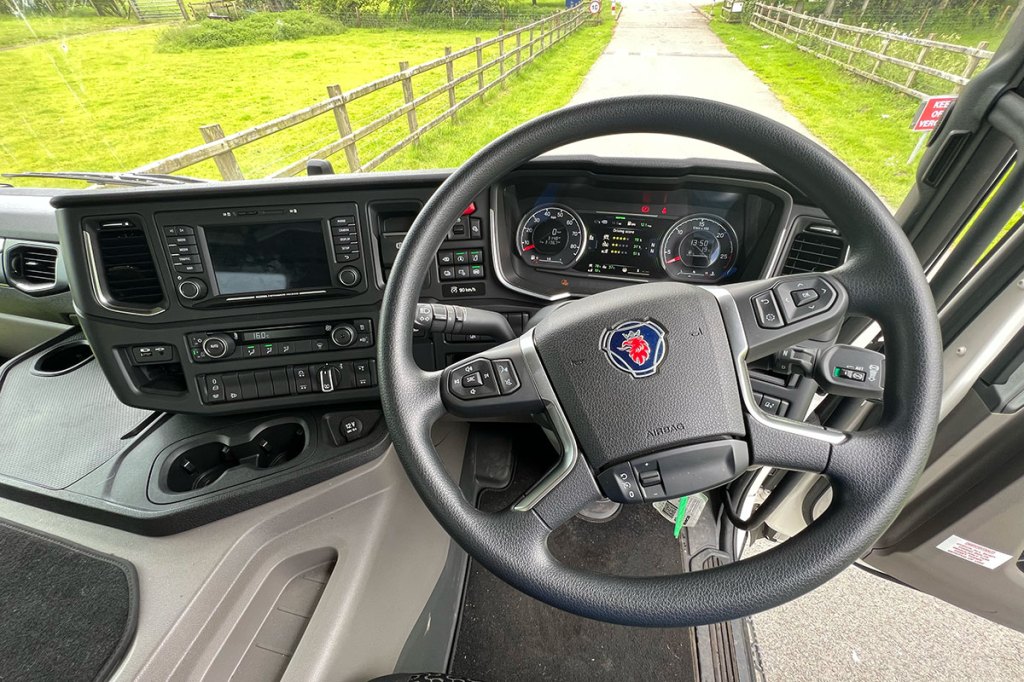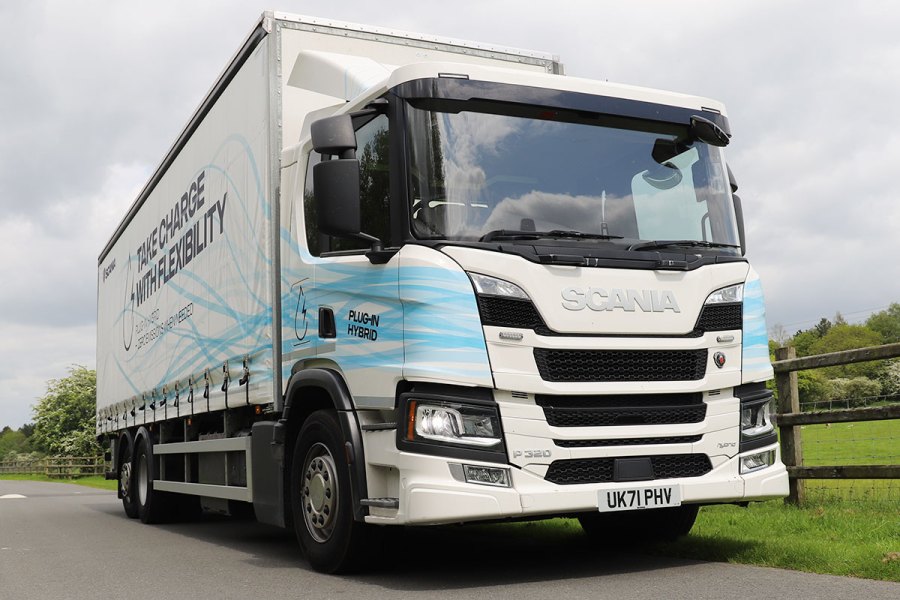Electric trucks don’t have the range to be viable for many applications. They cost too much and are heavy. But could a diesel truck with an electric motor for town running be a sensible option? Trucking took a Scania P320 Hybrid out for a spin…
By Pip Dunn
I like to think of myself as at least conscious that we need to reduce harmful emissions into the atmosphere, if not for us, then for our kids and more importantly our kids’ kids. We have to future proof the globe for those future generations.
And part of the way to do that is to reduce our reliance on fossil fuels and the harmful emission they produce and switch to so-called greener forms of energy. But it has to be done sensibly. Especially when we are loath to pay for it.
But I also believe the road haulage industry has done more than its fair share to reach those goals. Over the last three decades, we have seen diesel engine technology improve immeasurably in its quest to reduce emissions. At the risk of sounding like a broken record here, compare a Euro 6e truck engine with a Euro 0 truck, and the reduction in emissions is utterly remarkable and all for the good.
Not only that, but these new engines are also more fuel-efficient. Using less fuel also means fewer emissions and lower operating costs. Compare a Scania 460R Super from 2023 with, say, a new Scania 113 from 1988. They are poles apart in every field – efficiency, emissions, not to mention driver comfort and total cost of ownership.
But exhaust emissions are still there, albeit much reduced, and the drive to reduce them continues further. One way is eliminating the use of diesel fuel altogether. I have mixed views on the seemingly desperate drive to move to alternative fuels, which often can be a little blinkered. But I accept they are coming.
First up, the shift from diesel to electric or hydrogen is not like the shift from steam to diesel a century or more ago. That was – in its more simplistic case – a case of changing the fuel type and how it is used for propulsion rather than how it goes into the ‘engine’. In fact that switch was better as a tank full of diesel was much less labour intensive – and safer – than shovelling coal into a fire.
The biggest issue with the move to electrification, gas or other fuels is that requires a massive shift and investment in refuelling infrastructure. I have said, that to make fully electrified trucks, you will need a charging point in every parking bay of every truckstop or Motorway Service Area. Who will fund that investment? And despite it being a ‘public service’, many will insist such infrastructure ‘has to make a profit’.
I’m also of the view we are – at least initially – currently trying to electrify the wrong sorts of trucks. Well, that’s not strictly speaking completely true but what I mean is we need to prioritise the shift to electric vans, buses, taxis and local distribution trucks before we start to look at the same shift for heavy trucks.
Indeed, lowering harmful emissions in towns and cities has to be a priority and here I think hybrid technology has an important part to play. A truck that can run on diesel for the longer distance part of its work, out in the countryside and open spaces, and then shift to emission-free electric running when in built-up areas with mass population.
With that in mind, I was pleased to take a Scania P320 hybrid 6×2 rigid out for a drive. This truck is similar to the standard P320 in the fact it is fitted with the same DC09 9-litre five-cylinder SCR engine rated at 320hp at 1,900rpm and delivering a useful 1,600Nm of torque over a 1,050-1,350rpm band. It had the GRS895 12-speed gearbox and was fitted with the flat-roofed low-day cab. The rear axle is the R660 with a 1:2.92 ratio.
But where it differs is that it also has an integrated eMotor assist. Rated at 115kW (154hp) and 1,050Nm, it allows the truck to run wholly off electric power, but only for a short range of about an hour tops. However, those short distances can be where emission-free driving counts the most; in towns and cities where there are more people.
The truck had the slightly extended day cab which offers some useable room behind the seats for the driver’s personal effects,. Like all Scanias, however, the P series is part of a modular concept which means you can have this truck with the short day cab, the flat roof sleeper, the normal height sleeper or the high roof sleeper. You could also order it with a G or R cab of you need more space.
But that said, given the work this truck is doing its unlikely you’d need much other than a standard P or G day or sleeper cab. You can also get it as a 4×2 rigid for 18 tonnes.

On the road
The Hybrid concept is therefore simple – load the truck in an urban area, run on electric power until clear of the conurbation, then switch to diesel to undertake the ‘trunking’ during which time the battery will recharge, then when you arrive in the town, the driver can switch back to electric power for their raft of deliveries.
You have the ‘get out of jail’ card that if you start to run low on charge, then you can still switch to diesel as and when you need to. Provided you are carrying enough diesel, you won’t get stuck. A full recharge is done overnight or in between shifts, while the driver can top it up during their 45-minute break – assuming they are next to a charging point.
I was intrigued to see how this truck performed and what the business case for it. I took the truck for a run from the Scania training centre at Charnwood near Loughborough and headed out on a circular route with all manner of roads types, starting by heading of on the A46 towards Radcliffe then into Nottingham and back down the A453 to Ratcliffe and onto the M1 for a couple of junctions and back to the base. It was a good workout for sure.
But what I was interested in was the switch in power. On the road running on its diesel mode, it performed just like a typical Scania P series. It had plenty of power, 320hp is ideally suited for a 6×2 26-tonne chassis – although it’s not uncommon to see Scania 6×2 rigids with the 360hp version of the DC09 or even then 370/410hp version of the 13-litre DC13 engine.
So on the road, there is perhaps not too much to report, other than it was a typically smooth drive that I’ve come to expect from a P series Scania, with seamless gearshifts and minimal noise inside the well-appointed day cab. The dash is the same as the diesel-only version, and pretty much everything else is the same, so there should be no issues with familiarity for your driver.
Once in the city it’s time to switch modes, and here a simple flick of the switch on the dashboard to the left of the dash sees the truck change to electric power. The engine cuts out and the trucks glides effortlessly into electric mode. This means there are no exhaust emissions and virtually no noise; you can just about hear the slightest of whines as the motors do their stuff, but essentially the truck is now ultra-quiet.
That’s great in the city, although the driver needs to be on their guard as pedestrians, often in a world of their own with headphones or glued to their mobile phone screens may not hear you approaching and have an alarming tendency to walk out into roads with no regard for the possible presence of quiet electric vehicles!
Performance on electric is comparable with diesel although the more you accelerate, the quicker the battery’s charge will decrease. But for the short burst you are likely to use it, it’s fine.
I deliberately used it on electric power for as much as possible to see how the truck performed. But actually the truck comfortably got me out of the environs of Nottingham and onto the A453 with sufficient charge, so I stayed on electric right down to the M1. That represented a good few miles, so over the day I probably saved three gallons or more of diesel just by ‘playing around’ on the electric function.
Once you get used to the truck’s capabilities I can see drivers switching their driving behaviour accordingly and it is just plain common sense to reduce the use of the diesel. And once on the M1, and up to 56mph the battery starts to recharge rather nicely so I would have enough charge to glide into Loughborough town centre on electric had I chosen to do so.

Verdict
Everyone has an opinion on alternative fuels, but the fact is, there is a drive to eliminate diesel full stop. In fact from 2040, theoretically, you won’t be able to buy a new diesel truck in the EU, and that will also apply to the UK.
That might seem an age away, but it’s on its way and it’ll be here before we know it. So the industry is right to be – pardon the pun – plugging electric options heavily. The question still remains, can the infrastructure been increased quickly enough to make this power shift viable and affordable?
Remember such investment will means we’ll need charging points the length and breadth of the country, from rural Cornwall to the Scottish Highlands – although as an aside, I was amused to see a charging point at the remote outpost of Achnasheen Railway station in March (ironically with a Scania G450 8×4 diesel tipper parked near it!)
I have no doubt that electric trucks will work and those we currently have will be further improved on in the next three, five, ten years. If the battery life can offer a full day’s use and range without the need to recharge until the end of the shift, coupled with an abundance of recharging infrastructure then there is no reason why they can’t work. Battery technology is improving, and will continue to do so. Who know, it will also probably become easier as well. Who is to say there won’t be a system soon where trucks park over a charging pad in a truckstop which then makes contact with a charging pad on the truck to automatically rechange without the need to connect them?
But if that range can improve, and that infrastructure keeps up, then battery trucks are likely to be the future. However, many think that day is going to be much, much closer to 2040 than to 2023.
And with that in mind, in the meantime hybrids have a lot going for them – the ability to be eco-friendly in busy and built up areas, yet not hamstrung by range issues as well having the flexibility to use a diesel engine should they need to.
With this Scania, once you get used to it, you can use electricity as much as it will allow, for example, if you start the day on electric, switch to diesel, use electric for deliveries and then diesel for the way home, on that final you can actually switch to electric and basically run the battery down knowing you’ll be fully recharging it back at base, and in that respect it could seriously slash your diesel bills by 18% according to Scania.
That will help offset the higher cost of the truck. That said, I can see leasing as probably the best option for acquiring this, or indeed any other type of new alternative fuels truck for the next few years until the technology really reaches its peak and optimum efficiency. You don’t want to buy something and them be lumbered with an obsolete, old technology trucks in five years’ time that has little resale value or faces an expensive upgrade?
So currently this Scania is a very good proposition as a best of both worlds option to reduce your emissions and fuel bills without limiting you on its productivity.
It is a lower emission, more fuel efficient truck that won’t ever leave you fretting over low charge. It is quietest and cleanest in the areas it needs to be the most, there’s no lack of performance and it is a perfect fit for middle- to short-distance inner-urban distribution.
If it suits your operation, then it is well with checking out. It could be the sensible compromise that is the perfect fit for the current day.
We like
- Quiet on electric
- Potential to reduce fuel bills
- Scania quality
- Good performance
We don’t like
- Residuals unknown
- Technology could overtake it
Specifications
Scania P320 Hybrid 6×2/4
- Design GCW: 26,000kg
- Chassis: 5,100mm wheelbase
- Front axle: 8,000kg capacity.
- Rear axle: 11,500kg (midlift) 7,500kg (mid lift).
- Gearbox: GRS895 12-speed
- Engine: DC09 9-litre 5-cylinder in line, Euro 6e
- Max power: 320bhp @ 1,900 rpm
- Max torque: 1,600Nm @ 1,050-1,350rpm
- Cab: P Low extended day






